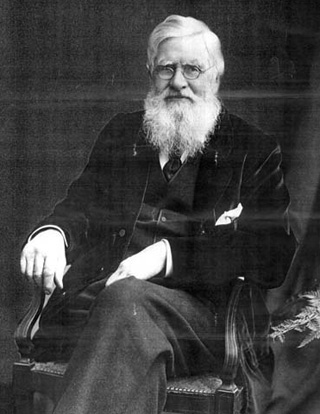
Alfred Wallace
|
|
The abbreviated biography is taken from Charles Smith’s excellent “The Alfred Russel Wallace Page” (citation below).
Alfred Russel Wallace was a notable English naturalist, evolutionist, geographer, anthropologist, social critic, and the co-discoverer with Charles Darwin of the theory of evolution and natural selection. Wallace was born 8 January 1823 at Usk in Monmouthshire, England. In 1844 he met Henry Walter Bates, already an accomplished entomologist, whose collections and collecting activities captured Wallace's interest. Together they planned an expedition to the Amazon and left for Belém, Brazil at the mouth of the Amazon on 25 April 1848. At first they worked as a team, but after a couple of years they split up. Wallace centered his activities in the middle Amazon and Rio Negro regions. Wallace left South America in 1852 due to ill health, while Bates remained for several more years. Unfortunately, the brig on which Wallace was sailing to England caught fire and sank, taking almost all of his possessions and collections with it. For ten days Wallace and his comrades struggled to survive in a pair of leaking lifeboats until they were sighted and picked up by a ship bound for England.
Wallace decided to continue his collecting in the Indonesian Archipelago and obtained a grant from the Royal Geographical Society to cover his passage. He arrived in Singapore on 20 April 1854 to begin what would turn out to be the defining period of his life. He spent nearly eight full years there, and during that period he undertook about 70 different expeditions to every important island in the archipelago. His collected 125,660 specimens, including more than a thousand species new to science, including cetoniine scarabs. The volume he later wrote describing his work and experiences there, The Malay Archipelago, is the most celebrated of all writings on Indonesia and ranks as one of the nineteenth century's best scientific travel books.
Wallace's discovery of natural selection occurred almost at the midpoint of his stay in the Malay Archipelago. By the end of his trip (and for the rest of his life) he was known as the greatest living authority on the region. He was especially known for his studies on its zoogeography, including his discovery and description of the faunal discontinuity that now bears his name. "Wallace's Line," extending between the islands of Bali and Lombok and Borneo and Sulawesi. This line marks the limits of the eastern extent of many Asian animal forms and, conversely, the limits of the western extent of many Australasian forms. Wallace left the Malay Archipelago in February of 1862 and returned to England on 1 April. His collecting activities had earned him a sizable nest egg with which he hoped he could retire to a quiet life as a country gentleman.
By the turn of the century, Wallace was very probably Britain's best known naturalist. His final two books were published in the year of his death, 1913. He remained active into his ninety-first year. He died in his sleep at Broadstone on 7 November 1913; three days later his remains were buried nearby. On 1 November 1915 a medallion bearing his name was placed in Westminster Abbey.
References:
Infography. Wallace, Alfred Russel (1823-1913). http://www.infography.com/content/167335534546.html.
Last accessed 7 April 2010.
Smith, C. H. Alfred Russel Wallace: A Capsule Biography. The Alfred Russel Wallace Page. http://people.wku.edu/charles.smith/index1.htm. Last accessed 7 April 2010.
|